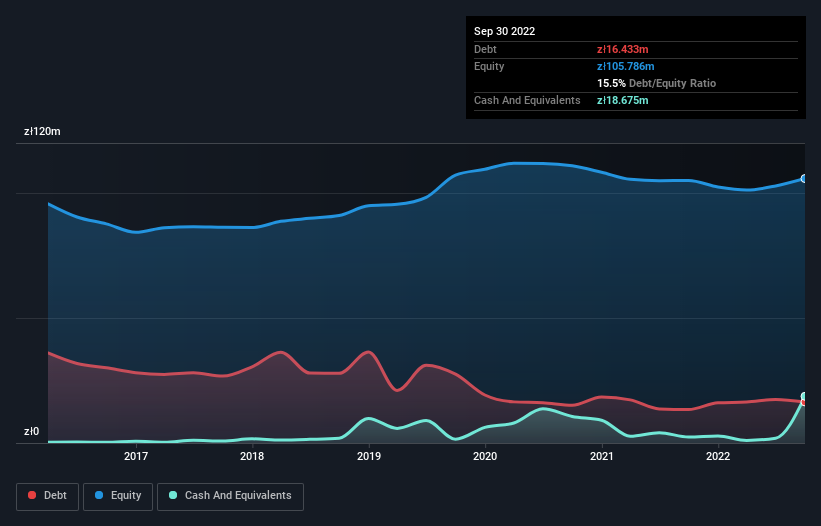
Howard Marks put it nicely when he said that, rather than worrying about share price volatility, 'The possibility of permanent loss is the risk I worry about... and every practical investor I know worries about.' When we think about how risky a company is, we always like to look at its use of debt, since debt overload can lead to ruin. We can see that Patentus S.A. (WSE:PAT) does use debt in its business. But the more important question is: how much risk is that debt creating?
Why Does Debt Bring Risk?
Debt assists a business until the business has trouble paying it off, either with new capital or with free cash flow. Ultimately, if the company can't fulfill its legal obligations to repay debt, shareholders could walk away with nothing. However, a more common (but still painful) scenario is that it has to raise new equity capital at a low price, thus permanently diluting shareholders. Of course, the upside of debt is that it often represents cheap capital, especially when it replaces dilution in a company with the ability to reinvest at high rates of return. When we think about a company's use of debt, we first look at cash and debt together.
Check out our latest analysis for Patentus
What Is Patentus's Debt?
As you can see below, at the end of September 2022, Patentus had zł16.4m of debt, up from zł13.4m a year ago. Click the image for more detail. However, its balance sheet shows it holds zł18.7m in cash, so it actually has zł2.24m net cash.

How Healthy Is Patentus' Balance Sheet?
We can see from the most recent balance sheet that Patentus had liabilities of zł15.6m falling due within a year, and liabilities of zł23.0m due beyond that. Offsetting these obligations, it had cash of zł18.7m as well as receivables valued at zł7.40m due within 12 months. So it has liabilities totalling zł12.5m more than its cash and near-term receivables, combined.
While this might seem like a lot, it is not so bad since Patentus has a market capitalization of zł47.8m, and so it could probably strengthen its balance sheet by raising capital if it needed to. But we definitely want to keep our eyes open to indications that its debt is bringing too much risk. Despite its noteworthy liabilities, Patentus boasts net cash, so it's fair to say it does not have a heavy debt load!
We also note that Patentus improved its EBIT from a last year's loss to a positive zł976k. The balance sheet is clearly the area to focus on when you are analysing debt. But it is Patentus's earnings that will influence how the balance sheet holds up in the future. So when considering debt, it's definitely worth looking at the earnings trend. Click here for an interactive snapshot.
But our final consideration is also important, because a company cannot pay debt with paper profits; it needs cold hard cash. Patentus may have net cash on the balance sheet, but it is still interesting to look at how well the business converts its earnings before interest and tax (EBIT) to free cash flow, because that will influence both its need for, and its capacity to manage debt. Over the last year, Patentus actually produced more free cash flow than EBIT. There's nothing better than incoming cash when it comes to staying in your lenders' good graces.
Summing Up
Although Patentus's balance sheet isn't particularly strong, due to the total liabilities, it is clearly positive to see that it has net cash of zł2.24m. And it impressed us with free cash flow of zł3.2m, being 330% of its EBIT. So we are not troubled with Patentus's debt use. When analysing debt levels, the balance sheet is the obvious place to start. But ultimately, every company can contain risks that exist outside of the balance sheet. For instance, we've identified 3 warning signs for Patentus that you should be aware of.
At the end of the day, it's often better to focus on companies that are free from net debt. You can access our special list of such companies (all with a track record of profit growth). It's free.
New: Manage All Your Stock Portfolios in One Place
We've created the ultimate portfolio companion for stock investors, and it's free.
• Connect an unlimited number of Portfolios and see your total in one currency
• Be alerted to new Warning Signs or Risks via email or mobile
• Track the Fair Value of your stocks
Have feedback on this article? Concerned about the content? Get in touch with us directly. Alternatively, email editorial-team (at) simplywallst.com.
This article by Simply Wall St is general in nature. We provide commentary based on historical data and analyst forecasts only using an unbiased methodology and our articles are not intended to be financial advice. It does not constitute a recommendation to buy or sell any stock, and does not take account of your objectives, or your financial situation. We aim to bring you long-term focused analysis driven by fundamental data. Note that our analysis may not factor in the latest price-sensitive company announcements or qualitative material. Simply Wall St has no position in any stocks mentioned.
About WSE:PAT
Patentus
Manufactures and sells mining machinery and equipment in Poland.
Flawless balance sheet and good value.
Market Insights
Community Narratives



